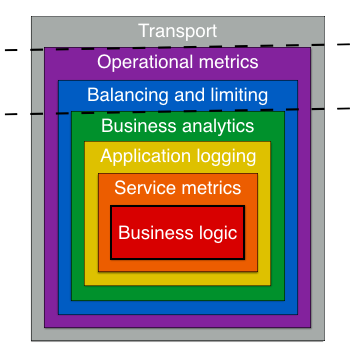Architecture and design 洋葱 中间件 装饰器
Go kit - Frequently asked questions https://gokit.io/faq/
Architecture and design
Introduction — Understanding Go kit key concepts
If you’re coming from Symfony (PHP), Rails (Ruby), Django (Python), or one of the many popular MVC-style frameworks out there, the first thing you should know is that Go kit is not an MVC framework. Instead, Go kit services are laid out in three layers:
- Transport layer
- Endpoint layer
- Service layer
Requests enter the service at layer 1, flow down to layer 3, and responses take the reverse course.
This may be a bit of an adjustment, but once you grok the concepts, you should see that the Go kit design is well-suited for modern software design: both microservices and so-called elegantmonoliths.
Transports — What are Go kit transports?
The transport domain is bound to concrete transports like HTTP or gRPC. In a world where microservices may support one or more transports, this is very powerful; you can support a legacy HTTP API and a newer RPC service, all in a single microservice.
When implementing a REST-ish HTTP API, your routing is defined within a HTTP transport. It’s most common to see routes defined in a HTTP Router function like this:
r.Methods("POST").Path("/profiles/").Handler(httptransport.NewServer(
e.PostProfileEndpoint,
decodePostProfileRequest,
encodeResponse,
options...,
))
Endpoints — What are Go kit endpoints?
An endpoint is like an action/handler on a controller; it’s where safety and antifragile logic lives. If you implement two transports (HTTP and gRPC), you might have two methods of sending requests to the same endpoint.
Services — What is a Go kit service?
Services are where all of the business logic is implemented. A service usually glues together multiple endpoints. In Go kit, services are typically modeled as interfaces, and implementations of those interfaces contain the business logic. Go kit services should strive to abide the Clean Architecture or the Hexagonal Architecture. That is, the business logic should have no knowledge of endpoint- or especially transport-domain concepts: your service shouldn’t know anything about HTTP headers, or gRPC error codes.
Middlewares — What are middlewares, in Go kit?
Go kit tries to enforce a strict separation of concerns through use of the middleware (or decorator) pattern. Middlewares can wrap endpoints or services to add functionality, such as logging, rate limiting, load balancing, or distributed tracing. It’s common to chain multiple middlewares around an endpoint or service.

Putting all these concepts together, we see that Go kit microservices are modeled like an onion, with many layers. The layers can be grouped into our three domains. The innermost service domain is where everything is based on your specific service definition, and where all of the business logic is implemented. The middle endpoint domain is where each method of your service is abstracted to the generic endpoint.Endpoint, and where safety and antifragile logic is implemented. Finally, the outermost transport domain is where endpoints are bound to concrete transports like HTTP or gRPC.
You implement the core business logic by defining an interface for your service and providing a concrete implementation. Then, you write service middlewares to provide additional functionality, like logging, analytics, instrumentation — anything that needs knowledge of your business domain.
Go kit provides endpoint and transport domain middlewares, for functionality like rate limiting, circuit breaking, load balancing, and distributed tracing — all of which are generally agnostic to your business domain.
In short, Go kit tries to enforce strict separation of concerns through studious use of the middleware (or decorator) pattern.
Architecture and design 洋葱 中间件 装饰器的更多相关文章
- Fastify 系列教程二 (中间件、钩子函数和装饰器)
Fastify 系列教程: Fastify 系列教程一 (路由和日志) Fastify 系列教程二 (中间件.钩子函数和装饰器) 中间件 Fastify 提供了与 Express 和 Restify ...
- 装饰器模式以及Laravel框架下的中间件应用
Laravel框架的中间件使用:从请求进来到响应返回,经过中间件的层层包装,这种场景很适合用到一种设计模式---装饰器模式. 装饰器模式的作用,多种外界因素改变对象的行为.使用继承的方式改变行为不太被 ...
- Fastify 系列教程二 (中间件、钩子函数和装饰器)
Fastify 系列教程: Fastify 系列教程一 (路由和日志) Fastify 系列教程二 (中间件.钩子函数和装饰器) Fastify 系列教程三 (验证.序列化和生命周期) Fastify ...
- 001-ant design pro 页面加载原理及过程,@connect 装饰器
一.概述 以列表页中的标准列表为主 Ant Design Pro 默认通过只需浏览器单方面就可处理的 HashHistory 来完成路由.如果要切换为 BrowserHistory,那在 src/in ...
- CBV加装饰器解决登录注册问题和 <<中间件>>
文本目录 CBV加装饰器解决登录注册问题 一:什么是中间件 二:中间件有什么用 三:自定义中间件 四:中间件应用场景 五:SCRF TOKEN跨站请求伪造 六: 其他操作 CBV加装饰器解决登录注册问 ...
- 浅谈Django的中间件与Python的装饰器
浅谈Django的中间件 与Python的装饰器 一.原理 1.装饰器是Python的一种语法应用,利用闭包的原理去更改一个函数的功能,即让一个函数执行之前先到另外一个函数中执行其他需求语句,在执行该 ...
- Flask(2)- 装饰器的坑及解决办法、flask中的路由/实例化配置/对象配置/蓝图/特殊装饰器(中间件、重定义错误页面)
一.装饰器的坑以及解决方法 1.使用装饰器装饰两个视图函数,代码如下 from flask import Flask, redirect, render_template, request, sess ...
- Django day15 (一) cbv装饰器 , 中间件
一: 装饰器 二: 中间件
- cbv装饰器 中间件 跨站请求伪造
给cbv下面的函数加装饰器 写一个验证用户登录的程序 前端页面 # 写一个装饰器验证session def login_auth(func): def inner(request,*args,**kw ...
随机推荐
- C#反编译工具ILSpy 反汇编
ILSpy反编译工具之C#反汇编 1.下载ILspy工具 https://github.com/icsharpcode/ILSpy#ilspy------- 注意: ILspy需要在电脑上安装.N ...
- k8s重器之Service
Service是k8s的核心,通过创建Service,可以为一组具有相同功能的容器应用提供一个统一的入口地址,并将请求进行负载分发到各个容器应用上. 目录: Service定义详解 Service基本 ...
- JAVA读取EXCEL_自动生成实体类
代码实现PropertyAnno.java import java.lang.annotation.ElementType; import java.lang.annotation.Retention ...
- @Transient 注解
使用 @Transient 表示该属性并非是一个要映射到数据库表中的字段,只是起辅助作用.ORM框架将会忽略该属性
- Oracle中除数为0的两种解决办法(decode与nullif)
Oracle中Decode函数,语句DECODE(tag,''ZCGS'',0,1)=decode(''@corp-No@'',''6010'',1,0) decode(字段或字段的运算,值1,值2, ...
- Servlet3.0提供的@WebServlet注解引用参数详情介绍
Servlet3.0提供的@WebServlet注解: servlet3.0所提供的@webservlet注解,用来将某个类注解为一个servlet类,简化了web.xml上的servlet配置, @ ...
- Docker-MsSqlServer和安装版本异同
创建SqlServer容器 docker run -e "ACCEPT_EULA=Y" -e "SA_PASSWORD=<YourStrong@Passw0rd&g ...
- TypeLoadException: 未能从程序集“ECS.GUI.Define, Version=1.0.0.0, Culture=neutral, PublicKeyToken=null”中加载类型“ECS.GUI.Define.ArmgAimPos”,因为它在 4 偏移位置处包含一个对象字段,该字段已由一个非对象字段不正确地对齐或重叠
TypeLoadException: 未能从程序集"ECS.GUI.Define, Version=1.0.0.0, Culture=neutral, PublicKeyToken=null ...
- Linux常用命令(df&dh)
在Linux下查看磁盘空间使用情况,最常使用的就是du和df了.然而两者还是有很大区别的,有时候其输出结果甚至非常悬殊. du的工作原理 du命令会对待统计文件逐个调用fstat这个系统调用,获取文件 ...
- 实现Vue的多页签组件
在之前的博客中 关于vue的多页面标签功能,对于嵌套router-view缓存的最终无奈解决方法 有写过vue的多页签功能的解决方案 可以看到我当时那个多页签的组件还是比较简单 的,只有打开跟关闭 ...
